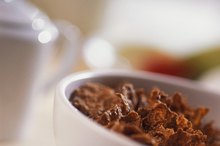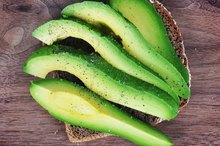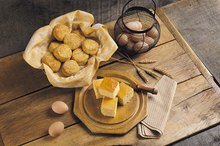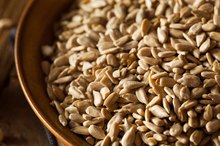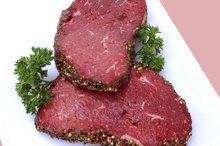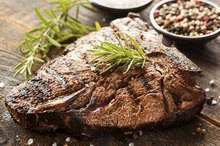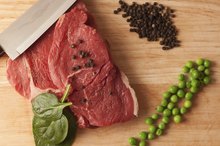What does fact checked mean?
At Healthfully, we strive to deliver objective content that is accurate and up-to-date. Our team periodically reviews articles in order to ensure content quality. The sources cited below consist of evidence from peer-reviewed journals, prominent medical organizations, academic associations, and government data.
- Centers for Disease Control and Prevention; Nutrition for Everyone – Iron and Iron Deficiency; Feb. 23, 2011
- American Dietetic Association, Eat Right; Health Implications of Dietary Fiber; 2008
The information contained on this site is for informational purposes only, and should not be used as a substitute for the advice of a professional health care provider. Please check with the appropriate physician regarding health questions and concerns. Although we strive to deliver accurate and up-to-date information, no guarantee to that effect is made.
Iron Levels in Whole Grains
Iron, an essential mineral in your diet, helps carry oxygen from your lungs to various cells throughout your body. A variety of foods, including whole grains, contain iron 1. Whole grains are more nutrient-dense than refined grains because they contain the entire grain – bran, germ and endosperm.
Recommended Intake
Your daily recommended intake of iron varies depending on your age and sex. Women of childbearing age require more iron than men, and pregnant women require more iron than other adult females. In general, males ages 19 and over should consume about 8 mg of iron daily, according to the Centers for Disease Control. Women ages 19 to 50 should consume 18 mg of iron per day; women over 50 should have 8 mg. Pregnant women should consume about 27 mg of iron per day. Lactating women require 9 mg daily.
- Your daily recommended intake of iron varies depending on your age and sex.
- Women ages 19 to 50 should consume 18 mg of iron per day; women over 50 should have 8 mg.
Iron Content in Whole Grains
Do Beans Have Iron?
Learn More
The amount of iron varies greatly between different types of whole grains. One slice of whole wheat bread contains 0.74 mg of iron; 1 cup of cooked bulgur contains 1.75 mg of iron; 1 cup of cooked quinoa contains 2.76 mg of iron; 1 cup of cooked brown rice contains 0.82 mg of iron; 1 cup of cooked wild rice contains 0.98 mg of iron; 1 cup of cooked pearled barley contains 2.09 mg of iron. Some whole grain breakfast cereals contain added iron. One brand supplies 18 mg -- more than a full day's supply for most adults -- per 3/4 cup.
- The amount of iron varies greatly between different types of whole grains.
Alternate Iron Sources
With the exception of iron-fortified breakfast cereals, most whole grains are not particularly high in iron. Numerous animal-based and plant-based foods are better sources of iron 1. Examples include 3 oz. of clams, 23.8 mg of iron; 3 oz. of oysters, 10.2 mg of iron; 3 oz. of beef, 3 mg of iron. Plant-based foods that provide iron include 1/2 cup of cooked soybeans, 4.4 mg; 1 oz. of roasted pumpkin seeds, 4.2 mg; 1/2 cup of white beans, 3.9 mg; 1/2 cup of cooked lentils, 3.3 mg of iron; and 1/2 cup of cooked spinach, 3.2 mg of iron.
- With the exception of iron-fortified breakfast cereals, most whole grains are not particularly high in iron.
- Plant-based foods that provide iron include 1/2 cup of cooked soybeans, 4.4 mg; 1 oz.
Nutritional Value of Whole Grains
How Much Iron Is in Total Cereal?
Learn More
While whole grains do not provide a rich source of iron, they provide high amounts of other nutrients. Whole grains make an excellent source of dietary fiber. Consuming whole grain foods can help you fulfill your daily recommended intake of fiber – about 25 g to 38 g. Whole grains also contain vitamin E, most of the B vitamins, essential fatty acids, magnesium, chromium and folate.
Related Articles
References
- American Diabetes Association: Food and Fitness – Whole Grain Foods
- United States Department of Agriculture: Nutrient Database
- American Diabetes Association: Food and Fitness – Carbohydrates
- American Diabetes Association: Food and Fitness – Diabetes Superfoods
- Abbaspour N, Hurrell R, Kelishadi R. Review on iron and its importance for human health. J Res Med Sci. 2014;19(2):164–174.
- National Heart, Lung, and Blood Institute. Iron-Deficiency Anemia.
- Vaucher P, Druais PL, Waldvogel S, Favrat B. Effect of iron supplementation on fatigue in nonanemic menstruating women with low ferritin: a randomized controlled trial. CMAJ. 2012;184(11):1247-54. doi:10.1503/cmaj.110950
- Stugiewicz M, Tkaczyszyn M, Kasztura M, Banasiak W, Ponikowski P, Jankowska EA. The influence of iron deficiency on the functioning of skeletal muscles: experimental evidence and clinical implications. Eur J Heart Fail. 2016;18(7):762-73. doi:10.1002/ejhf.467
- Cherayil BJ. The role of iron in the immune response to bacterial infection. Immunol Res. 2011;50(1):1–9. doi:10.1007/s12026-010-8199-1
- Jáuregui-lobera I. Iron deficiency and cognitive functions. Neuropsychiatr Dis Treat. 2014;10:2087-95. doi:10.2147/NDT.S72491
- Cleveland Clinic. How to Tell If You Have Iron Deficiency Anemia. Updated October 30, 2017.
- Murat S, Ali U, Serdal K, et al. Assessment of subjective sleep quality in iron deficiency anaemia. Afr Health Sci. 2015;15(2):621–627. doi:10.4314/ahs.v15i2.40
- Dosman CF, Brian JA, Drmic IE, et al. Children with autism: effect of iron supplementation on sleep and ferritin. Pediatr Neurol. 2007;36(3):152-8. doi:10.1016/j.pediatrneurol.2006.11.004
- Office of Dietary Supplements. Iron Fact Sheet for Health Professionals. Updated October 16, 2019.
Writer Bio
Kathryn Gilhuly is a wellness coach based in San Diego. She helps doctors, nurses and other professionals implement lifestyle changes that focus on a healthy diet and exercise. Gilhuly holds a Master of Science in health, nutrition and exercise from North Dakota State University.

